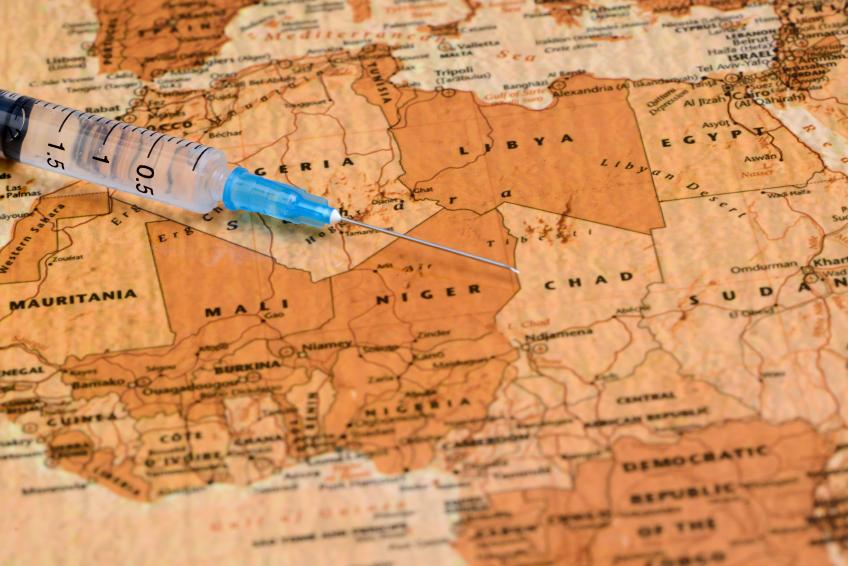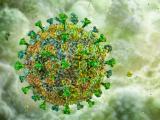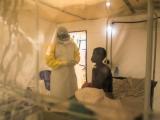Note: Two new sections were added to the end of this report on the afternoon of Feb 17, including quotes from Joan Fusco, PhD. An explanation for "Team B" (in paragraph 5) was also added.
A team of health experts concerned about the long-term threat of Ebola released today a lengthy set of recommendations for the development of Ebola vaccines, saying that the push to test vaccines in West Africa must continue even if fading cases make it difficult to tell for certain if the inoculations are working.
The report, "Recommendations for Accelerating the Development of Ebola Vaccines," says that all vaccines should be tested in clinical trials, even if an early winner emerges, because more than one kind of vaccine may be needed to quell the current epidemic and to protect at-risk groups against the threat of future outbreaks.
It also suggests that if the waning of the epidemic makes it hard to judge the performance of the vaccines, it may be possible to license a vaccine on the basis of animal data and human immune responses. Other recommendations call for placing African stakeholders in the forefront of decisions affecting the safety and well-being of populations hit by the epidemic.
Effort led by Wellcome Trust, CIDRAP
The report was released by the Wellcome Trust and the University of Minnesota's Center for Infectious Disease Research and Policy (CIDRAP), publisher of CIDRAP News. Prepared by 26 experts in various realms of vaccine work and public health, the document builds on an interim report, published in January, that set out guiding principles for Ebola vaccine development.
The aim of the effort is to help guide global efforts to expedite the delivery of safe and effective Ebola vaccines both to help stop the current epidemic and to improve preparedness for future Ebola outbreaks. The group of authors calls itself "Team B" in recognition of the primary role of the World Health Organization (WHO) and national governments in leading the Ebola response.
"Despite falling infection rates in West Africa, the risk that the current Ebola outbreak may not be brought completely under control remains. The accelerated development of candidate vaccines, in collaboration between governments, industry, academia and philanthropy, is essential," Jeremy Farrar, MD, PhD, director of the Wellcome Trust, said in a press release.
"We may see an end to this Ebola epidemic within the year if we continue with the current remarkable efforts, but we must not be complacent about the inevitable future epidemics of Ebola and other emerging infectious diseases."
Michael T. Osterholm, PhD, MPH, director of CIDRAP, observed that in the context of declining Ebola cases in West Africa, the main message of the report is that "having an evaluation of the effectiveness, safety, and community acceptance of Ebola vaccines is still very critical to a long-term strategy for controlling Ebola in Africa.
"One of the challenges we face in public health is that when something is a crisis we throw everything we have at it, and when it's no longer in the headlines we tend to forget about it," he said in an interview.
"While the West African epidemic is still not over, we have to consider the importance of a vaccine for stopping this epidemic and future ones. This report lays out a plan for both current and future needs for a vaccine."
Another member of the team that wrote the report stressed the expertise of the authors and the effort it took to produce the report in a short time.
Clement A. Adebamowo, BM ChB, ScD, professor of epidemiology and public health, University of Maryland in Baltimore, and chair of the Nigerian National Health Research Ethics Committee, commented in an interview, "The most important message I think is not so much what is contained in the report but that a multidisciplinary, high-level, very talented set of people were brought together to, over a short period of time, think and collaborate on what will be needed to get an effective Ebola virus vaccine out into the public."
"Current efforts will be significantly improved by paying attention to the content of the report," he said, adding that the report should help to minimize mistakes and challenges along the path to effective, safe vaccines.
Virus could become entrenched
The report says there is a real possibility that Ebola will become endemic in West Africa, creating a risk of ongoing, sporadic local flare-ups. Accordingly, the availability of an effective vaccine will be "a crucial component of an integrated control approach that includes classic public health measures, medical treatment, and community interventions."
The first phase 2/3 trial of Ebola vaccines was launched Feb 2 in Liberia. It will test two Ebola vaccines: ChAd3, developed by the US National Institutes of Health and GSK, and VSV-EBOV, which was developed by the Canadian government and licensed to New Link Genetics and Merck. They will be compared with a placebo. Both vaccines use other viruses to deliver Ebola genetic material.
Two other Ebola vaccines, made by Johnson & Johnson (J&J) and Novavax, are currently in phase 1 trials.
The 66-page report includes chapters and recommendations on vaccine manufacturing, determination of vaccine safety and efficacy, regulatory pathways, ethics, community engagement, vaccination strategies, and funding.
On vaccine manufacturing, the document says estimates of the number of doses needed range from fewer than 100,000 to 12 million. The World Health Organization (WHO) has said that Merck and J&J each produce up to 5 million doses this year and that GSK expects to be able to produce about 1 million per month by the end of this year, according to the report.
Among several manufacturing-related recommendations, the report says the initial focus should be on making monovalent (single-strain) vaccines for Zaire Ebola virus, since that is likely to be faster than making multivalent vaccines. Also, it calls for assessing the possibility of eventually developing manufacturing capacity in Africa.
Determining vaccine efficacy
The report describes multiple obstacles to the goal of determining vaccines' efficacy in clinical trials. They include the uncertainty over future Ebola incidence in the affected countries, the lack of immune system markers (correlates of protection) showing that a vaccinated person has protection against infection, the possible need for two shots (a prime-boost regimen), and the potential for some level of existing "herd immunity" in some areas because of past subclinical infections.
Amplifying a point made in the interim report, the new document says that if one vaccine shows convincing efficacy early in clinical trials and is in good supply, continuing other trials would raise ethical questions that may need to be addressed by in-country ethics committees, since that would mean trial participants would not get the shot that appears effective.
Quickly rolling out one vaccine that seems to perform well may yield short-term benefits, but it could backfire if testing of other vaccines were halted and the chosen vaccine was later found to have drawbacks, such as short-lived immunity or manufacturing snags, the authors said. "Choosing only one vaccine would lead to a single point of vulnerability and could limit vaccine choices for the future."
Accordingly, the experts recommend that all promising vaccines be tested in clinical trials. But because human trials may be possible only in the context of the current epidemic, and the decline in cases is raising doubts even about this option, they add, "Alternatives to clinical efficacy trials in the absence of an epidemic should be considered that would allow vaccine candidates a development path to licensure, (eg, use of the US Food and Drug Administration [FDA] Animal Rule)."
The Animal Rule allows for FDA approval of a vaccine or drug for which human trials are not ethical or feasible, provided the product is safe in humans and that testing in animals suggests it is reasonably likely to benefit humans.
Another reason to continue trials of all promising vaccines is that they can yield valuable data on vaccine safety, even if an efficacy determination is not possible, the authors wrote.
Another recommendation related to the efficacy question calls for obtaining post-vaccination blood specimens with the aim of determining correlates of protection. In addition, seroprevalence surveys to determine the level of herd immunity should be considered.
Clearing regulatory hurdles
A section on the challenges to getting Ebola vaccines approved for use explains that the FDA has other options besides the Animal Rule that offer models for possible regulatory pathways.
One is "accelerated approval," which requires clinical trial data showing that the vaccine affects a "surrogate end point," other than survival or severe illness, that is likely to predict clinical benefits. Another option is the FDA's Emergency Use Authorization (EUA), which allows the agency to permit the use of an unlicensed product during a declared public health emergency for a population not enrolled in clinical trials.
Among its recommendations on regulatory issues, the authors advised that:
- The WHO should continue to coordinate international efforts to determine appropriate regulatory pathways for Ebola vaccines and provide expert oversight and guidance.
- National regulatory agencies of the affected countries should harmonize their approval requirements and identify flexible options for accelerated vaccine approval, including the FDA Animal Rule, when appropriate.
- The national regulatory agencies "should consider reciprocity for the FDA's EUA, which may be unique among regulatory options for providing emergency access to new Ebola vaccines."
- The WHO should consider creating a permanent international forum to coordinate and expedite regulatory review processes, in collaboration with national regulatory agencies.
Ethics and community engagement
A section on ethics emphasizes the necessity of local involvement in decisions on the use of Ebola vaccines in the current epidemic: "The urgency and speed of vaccine development and delivery must not be allowed to trump the imperative that African stakeholders are positioned at the forefront of decisions that affect the safety, well-being, and resilience of the populations hardest hit by EVD [Ebola virus disease]."
The report calls for bolstering local "bioethics capacity" for both the present and the future. It also recommends setting up a fund to cover the cost of bringing in outside ethics experts as needed. Other recommendations deal with the respectful handling and use of tissue and blood samples and the need for communicating how vaccine-related adverse events will be reported and addressed.
In a chapter on community engagement to promote vaccine acceptance, the authors observe that past political strife and civil war have eroded trust in political leaders in West Africa and that rumors of "nefarious intentions" connected to past vaccine campaigns continue to fester. They assert that community engagement efforts need to be tailored to each country, region, and group.
As in the case of ethics decisions, the report stresses the importance of enlisting West African leaders in community engagement efforts: "Leaders selected by their communities rather than imposed on them by others are essential to [community engagement] efforts that are culturally informed, are practical, and build trust."
Vaccination strategies
Another chapter of the report discusses vaccination strategies for the current epidemic—if it is still smoldering after completion of vaccine trials—and for the future.
For the current epidemic, the experts call for initially vaccinating those at highest risk for Ebola, including frontline healthcare workers, Ebola response teams, and funeral workers. If vaccine supplies are adequate, the next stage would be "ring vaccination" of case contacts, home-care providers, their secondary contacts, and others in the same area.
Another recommended priority group, assuming there is enough vaccine, consists of critical infrastructure personnel such as police, fire fighters, first responders, and military personnel.
The report also recommends developing mass vaccination strategies for whole regions affected by the epidemic, if vaccine supplies are sufficient. "Use of a single-dose vaccine will greatly simplify this process," it says. Adults should be targeted first, because they are at greatest risk in this epidemic.
Beyond the present crisis, the authors recommend that authorities:
- Work to resolve cold-chain challenges, meaning problems due to the requirement that vaccines be kept frozen
- Consider stockpiling vaccines for future use
- Consider routine vaccination of healthcare workers in high-risk areas
- Consider population-wide vaccination if the epidemiology of EVD changes and the risk appears high enough to warrant the cost and effort
Funding challenges
The authors also note a number of obstacles to the goal of securing enough funding to bring Ebola vaccines to West Africa, including waning public interest in the epidemic. They stress the need to obtain enough money to make sure that clinical trials of all vaccines are completed, even if one vaccine looks initially like a winner.
"There is a high possibility that at least two types of vaccine will be needed: (1) a single-dose vaccine that provides immediate immunogenicity and protection for outbreak containment and (2) a vaccine that produces durable protection for use during non-outbreak settings to vaccinate key healthcare workers, for whom a prime-boost strategy may work."
The report's funding recommendations include, among others:
- Securing commitment to long-term funding, meaning at least 2 years
- Committing to transparency in financial data and vaccine pricing
- Considering establishing an "integrated global funding strategy" for the long-term support of Ebola vaccines
The optimal vaccine
In other material, the authors offer a set of optimal and minimal criteria for Ebola vaccines, which are mostly similar to what was spelled out in the interim report a month ago. There are separate standards for reactive-use vaccines, meaning those for fighting the current epidemic or future ones, and prophylactic vaccines intended for protection against endemic EVD.
The optimal reactive-use vaccine should require just one dose, have 90% efficacy, elicit rapid onset of immunity and 2 years of protection, and not require an adjuvant, the report says. It should be suitable for everyone, including special populations such as pregnant women and those with chronic disease. Further, the vaccine should be a monovalent product for the Zaire strain of Ebola, with 5 million doses available by the third quarter of this year.
For prophylactic vaccines, the optimal product would provide 10 years of protection against Zaire Ebola, Sudan Ebola, and Marburg virus (a close relative of Ebola), the report says. The dose of antigen should be small enough to permit a high production yield, and ideally the vaccine should be a single product, not requiring a booster or diluent.
Possible impact of report
One of the report authors, Joan Fusco, PhD, of CBR International Corp., a biomedical consulting firm, said she believes that the earlier interim report has already influenced Ebola vaccine efforts, and expressed the hope that the new report will extend that influence. She is vice president of regulatory affairs for CBR's Eastern Region.
In e-mailed comments, Fusco said the report addresses in one document the many challenges and issues involved in biopharmaceutical product development, with its quality requirements, time constraints, and cost factors.
"By focusing the overall process on key areas, including product definition (target product profile-TPP) [the vaccine criteria], cross-functional development critical paths, and regulatory, policy and commercial factors, it is my hope that decision-makers will use the report as their guide," she said.
"My understanding is that the TPP has already been useful to WHO and 'Team A' as a tool for short and long-term solutions for developing Ebola vaccines that address the dynamic product attributes needed to stop and prevent this deadly disease."
Fusco also said the Ebola vaccine efforts made thus far have been generally in line with the recommendations in the new report.
"From the information available, there are many activities that have been accelerated to address this crisis and under severe constraints; most of these have been aligned with the fundamental findings of the report," she said.
"The overall response has been incredible and the efforts are to be applauded; however, it has been a response developed concurrent with the crisis, rather than in advance of it. My additional hope is that the report will serve in ongoing efforts to develop proactive policies and action plans to address future emerging infectious disease threats. We can no longer be unprepared and reactive to public health threats of global concern."
See also:
Feb 17 Team B report
Jan 12 CDRAP News story on interim report
Feb 2 CIDRAP News story on vaccine trial launch
Feb 13 CIDRAP News story on Novavax vaccine trial



















